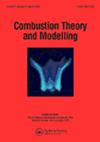在自适应化学方法中使用低维模拟生成数据库的可行性研究
IF 1.6
4区 工程技术
Q4 ENERGY & FUELS
引用次数: 2
摘要
大涡模拟(LES)/概率密度函数(PDF)方法现已成熟,可用于模拟具有强烈湍流化学相互作用的具有挑战性的湍流燃烧配置。众所周知,与类似火焰的湍流燃烧模型相比,传输PDF方法在计算上是昂贵的。为了解决这种成本差异,开发了预分区自适应化学(PPAC)方法。PPAC需要离线预处理阶段,从代表性成分的初始数据库开始生成一组简化模型。在运行时,这组简化模型在反应分步过程中被动态利用,从而节省了计算量。我们最近将PPAC与原位自适应制表(ISAT)相结合,以进一步降低计算成本。我们已经表明,组合方法将湍流燃烧的大规模LES/粒子PDF模拟的每个时间步长的平均壁时钟时间减少了39%。PPAC中的一个关键假设是,离线阶段使用的初始数据库代表运行时遇到的组合。在我们之前的研究中,这一假设得到了很好的满足,因为初始数据库由从湍流燃烧模拟本身提取的成分组成。因此,一个关键的悬而未决的问题仍然是,是否可以在不访问湍流燃烧模拟的情况下生成这样的数据库。为了回答这个问题,在目前的工作中,我们探索了是否可以从计算高效的低维模拟中提取用于形成这样一个数据库的成分,例如1D逆流火焰和部分搅拌反应器。我们表明,使用从部分搅拌的反应器配置中提取的组合物生成的数据库导致与最佳情况相当的性能,其中该数据库由直接从LES/PDF模拟本身提取的组合物组成。本文章由计算机程序翻译,如有差异,请以英文原文为准。
A feasibility study on the use of low-dimensional simulations for database generation in adaptive chemistry approaches
Large eddy simulation (LES)/ Probability Density Function (PDF) approaches are now well established and can be used for simulating challenging turbulent combustion configurations with strong turbulence chemistry interactions. Transported PDF methods are known to be computationally expensive compared to flamelet-like turbulent combustion models. The pre-partitioned adaptive chemistry (PPAC) methodology was developed to address this cost differential. PPAC entails an offline preprocessing stage, where a set of reduced models are generated starting from an initial database of representative compositions. At runtime, this set of reduced models are dynamically utilised during the reaction fractional step leading to computational savings. We have recently combined PPAC with in-situ adaptive tabulation (ISAT) to further reduce the computational cost. We have shown that the combined method reduced the average wall-clock time per time step of large-scale LES/particle PDF simulations of turbulent combustion by 39%. A key assumption in PPAC is that the initial database used in the offline stage is representative of the compositions encountered at runtime. In our previous study this assumption was trivially satisfied as the initial database consisted of compositions extracted from the turbulent combustion simulation itself. Consequently, a key open question remains as to whether such databases can be generated without having access to the turbulent combustion simulation. Towards answering this question, in the current work, we explore whether the compositions for forming such a database can be extracted from computationally-efficient low-dimensional simulations such as 1D counterflow flames and partially stirred reactors. We show that a database generated using compositions extracted from a partially stirred reactor configuration leads to performance comparable to the optimal case, wherein the database is comprised of compositions extracted directly from the LES/PDF simulation itself.
求助全文
通过发布文献求助,成功后即可免费获取论文全文。
去求助
来源期刊

Combustion Theory and Modelling
工程技术-工程:化工
CiteScore
3.00
自引率
7.70%
发文量
38
审稿时长
6 months
期刊介绍:
Combustion Theory and Modelling is a leading international journal devoted to the application of mathematical modelling, numerical simulation and experimental techniques to the study of combustion. Articles can cover a wide range of topics, such as: premixed laminar flames, laminar diffusion flames, turbulent combustion, fires, chemical kinetics, pollutant formation, microgravity, materials synthesis, chemical vapour deposition, catalysis, droplet and spray combustion, detonation dynamics, thermal explosions, ignition, energetic materials and propellants, burners and engine combustion. A diverse spectrum of mathematical methods may also be used, including large scale numerical simulation, hybrid computational schemes, front tracking, adaptive mesh refinement, optimized parallel computation, asymptotic methods and singular perturbation techniques, bifurcation theory, optimization methods, dynamical systems theory, cellular automata and discrete methods and probabilistic and statistical methods. Experimental studies that employ intrusive or nonintrusive diagnostics and are published in the Journal should be closely related to theoretical issues, by highlighting fundamental theoretical questions or by providing a sound basis for comparison with theory.
 求助内容:
求助内容: 应助结果提醒方式:
应助结果提醒方式:


